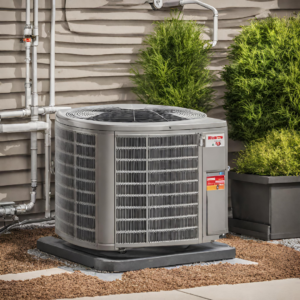Common Misconceptions About HVAC Systems and the Truth Behind Them
 HVAC systems are integral to modern living and working environments for several crucial reasons. First and foremost, they ensure indoor comfort by regulating temperature and humidity, creating an optimal environment for human well-being and productivity.
HVAC systems are integral to modern living and working environments for several crucial reasons. First and foremost, they ensure indoor comfort by regulating temperature and humidity, creating an optimal environment for human well-being and productivity.
Properly functioning HVAC systems also play a vital role in maintaining indoor air quality by filtering out pollutants and providing adequate ventilation, which is essential for health and reducing the risk of airborne illnesses.
Additionally, these systems are key to energy efficiency and environmental sustainability, as they enable precise control over energy consumption, helping to reduce utility costs and decrease greenhouse gas emissions.
We want to unveil some common misconceptions that many people have about these essential components of our indoor environments.
- HVAC Systems Only Control Temperature
- Bigger HVAC Systems Are Always Better
- Closing Vents in Unused Rooms Saves Energy
- Regular Maintenance Isn’t Necessary for HVAC Systems
- All Air Filters Are the Same
- Thermostat Placement Doesn’t Matter
Our job at Jacobs and Rhodes, as Comfort Engineers, is to help you have a clearer understanding of these HVAC misconceptions and how they can affect your home or business.
Misconception 1: HVAC Systems Only Control Temperature
One of the most common misconceptions about HVAC systems is the belief that they only control temperature.
While it’s true that heating and cooling are a fundamental aspect of HVAC systems, they do much more than that.
HVAC systems are responsible for creating a comfortable and healthy indoor environment, and temperature regulation is just one part of the equation.
The Truth
HVAC stands for Heating, Ventilation, and Air Conditioning, and each of these components serves a unique purpose.
Ventilation, for example, plays a crucial role in maintaining indoor air quality by exchanging stale indoor air with fresh outdoor air. It helps to remove pollutants, allergens, and moisture, which is essential for a healthy living or working environment.
Moreover, modern HVAC systems are equipped with advanced features and technologies that allow for precise control of indoor conditions. They can regulate humidity levels, filter the air, and maintain consistent airflow, all of which contribute to comfort and well-being.
So, HVAC systems are not limited to temperature control; they provide comprehensive solutions for ensuring a pleasant and healthy indoor atmosphere. Understanding the full scope of their capabilities is essential for optimizing their performance and getting the most out of your system.
Misconception 2: Bigger HVAC Systems Are Always Better
Another common misconception in the world of HVAC is the notion that bigger HVAC systems are always superior.
Many people believe that larger systems will cool or heat a space more effectively, but this oversimplification can lead to inefficient and costly solutions.
The Truth
The size of an HVAC system should be carefully matched to the specific needs of the space it is intended to serve.
Installing an oversized system can actually be detrimental in several ways:
- First, it can result in uneven temperature distribution, leading to hot and cold spots within the building. This is because an oversized system may reach the desired temperature too quickly, shutting off before it can properly dehumidify the air or circulate it effectively.
- Second, bigger systems consume more energy and are less efficient, which translates to higher utility bills. They also have more frequent on/off cycles, causing wear and tear on the system and shortening its lifespan.
A correctly sized HVAC system will provide better comfort, energy efficiency, and longevity.
Bigger isn’t always better in the world of HVAC; the right size is what matters most.
Misconception 3: Closing Vents in Unused Rooms Saves Energy
Closing vents in rooms that aren’t in use saves energy, right? Wrong.
The idea seems intuitive – if you’re not using a room, why waste energy on it?
The Truth
While this concept may sound like a simple and effective energy-saving strategy, it can actually be counterproductive and potentially harmful to your HVAC system.
Modern HVAC systems are designed to operate as a balanced and integrated system, and closing vents in unused rooms can disrupt this balance.
When you close a vent in one room, it creates an increase in air pressure in the ducts, which can lead to air leakage and wasted energy elsewhere in the system.
The HVAC system still attempts to push the same amount of air through the ductwork, which can result in reduced efficiency, higher energy consumption, and increased wear and tear on the system.
Moreover, closing vents can affect the temperature distribution in your home, causing uneven heating or cooling. It can lead to temperature imbalances, making some areas too hot or too cold, while overworking the system to compensate for these variations.
The better approach for energy efficiency and indoor comfort is to allow the HVAC system to operate as designed.
If you want to save energy in unoccupied rooms, consider adjusting the thermostat setting to a slightly lower or higher temperature, depending on the season, or explore zoning systems that allow you to control the temperature in individual rooms more effectively.
Misconception 4: Regular Maintenance Isn’t Necessary for HVAC Systems
One prevalent misconception is the belief that HVAC systems can function optimally without regular maintenance. Some homeowners and business owners may underestimate the importance of routine maintenance, thinking that their systems can run trouble-free indefinitely.
The Truth
Regular maintenance is a critical aspect of HVAC system ownership. Neglecting maintenance can lead to a host of issues, including reduced performance, higher energy bills, and even premature system failure.
Here are a few key points that illustrate why regular maintenance is essential:
- Efficiency: Over time, dust, debris, and dirt can accumulate in your HVAC system, affecting its efficiency. A well-maintained system operates more efficiently, which translates to lower energy consumption and lower utility bills.
- Longevity: HVAC systems that receive regular maintenance tend to have longer lifespans. This not only saves you the cost of early replacements but also reduces the environmental impact of manufacturing and disposing of HVAC equipment.
- Reliability: Routine maintenance helps identify and address potential issues before they turn into major problems. Preventive measures can save you from unexpected breakdowns and costly emergency repairs.
- Air Quality: Clean filters and well-maintained components contribute to better indoor air quality. Neglecting maintenance can lead to poor air quality, which can negatively impact the health of occupants.
- Warranty: Many HVAC manufacturers require regular maintenance to keep warranties valid. Neglecting maintenance might void your warranty, leaving you responsible for costly repairs or replacements.
Misconception 5: All Air Filters Are the Same
Thinking all air filters used in HVAC systems are essentially identical and that any filter will do the job of improving indoor air quality is another misconception.
The Truth
In reality, not all air filters are created equal.
Here’s why the “one-size-fits-all” approach is inaccurate:
- Filtration Efficiency: Air filters are rated based on their Minimum Efficiency Reporting Value (MERV) or High Efficiency Particulate Air (HEPA) rating. Filters with higher MERV ratings can capture smaller particles, including allergens, dust, and even some viruses and bacteria.
- Specific Needs: The choice of air filter should match the specific needs of your household or workspace. For individuals with allergies or asthma, high-efficiency filters can be beneficial in capturing allergens. In environments with high levels of pollutants, like in industrial settings, specialized filters may be necessary to ensure clean air.
- System Compatibility: Some HVAC systems may not be compatible with certain types of air filters. Using the wrong filter can impede airflow, reduce system efficiency, and even lead to damage.
- Replacement Frequency: Different filters have varying lifespans. Cheaper filters may need more frequent replacement, which can offset any initial cost savings.
Misconception 6: Thermostat Placement Doesn’t Matter
Many people believe that the location of their thermostat within their home or office is inconsequential.
As long as it’s somewhere on the wall, it should do its job, right?
This misconception can lead to suboptimal temperature control and energy inefficiency.
The Truth
Thermostat placement is critical for effective temperature regulation and energy efficiency.
Here’s why it matters:
- Temperature Accuracy: The thermostat measures the temperature of the room in which it’s located. If it’s placed in a room that tends to be significantly colder or warmer than other areas of the building, the thermostat may not accurately represent the comfort level in the spaces you use most.
- Influence on HVAC Cycling: The thermostat’s location can directly affect when your HVAC system turns on and off. Placing it in a room with extreme temperature variations, such as near a drafty door or a sunny window, can cause the system to cycle more frequently than necessary, resulting in energy waste and potential wear and tear on the equipment.
- Occupancy Considerations: Ideally, the thermostat should be located in a room where you spend a significant amount of time. Placing it in a hallway, closet, or rarely used space may not provide an accurate representation of your comfort needs.
- Zoning Efficiency: Modern HVAC systems may offer zoning capabilities, where you can control different areas independently. Proper thermostat placement is crucial for the effectiveness of zoning, as each zone should have its thermostat to accurately regulate temperature in that area.
Conclusion
HVAC systems are the unsung heroes of modern living and working environments. They do far more than just regulate temperature; they create the comfortable, healthy, and energy-efficient spaces we rely on every day. However, there are several misconceptions that can hinder the performance and efficiency of these systems.
Our mission at Jacobs and Rhodes, as Comfort Engineers, is to dispel these misconceptions and ensure you have a clear understanding of your HVAC system.
With the right knowledge, you can make informed decisions that enhance your comfort, save energy, and promote a healthier living or working environment. So, whether you’re upgrading your HVAC system, adjusting your thermostat, or choosing an air filter, keep in mind the truth behind these common misconceptions, and you’ll be on your way to a more efficient and comfortable indoor space.
Contents
- 1 Misconception 1: HVAC Systems Only Control Temperature
- 2 Misconception 2: Bigger HVAC Systems Are Always Better
- 3 Misconception 3: Closing Vents in Unused Rooms Saves Energy
- 4 Misconception 4: Regular Maintenance Isn’t Necessary for HVAC Systems
- 5 Misconception 5: All Air Filters Are the Same
- 6 Misconception 6: Thermostat Placement Doesn’t Matter
- 7 Conclusion

 Jacobs and Rhodes
Jacobs and Rhodes Jacobs and Rhodes
Jacobs and Rhodes